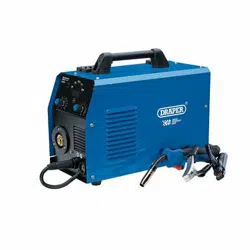Loading ...
Loading ...
Loading ...

–
10
–
clean of grease, dirt, paint and rust. Clean with a wire
brush as necessary. Position the earth clamp as close
as possible to the working area and ensure a tight grip is
achieved.
Select the welding current based on the thickness of the
material. A thick piece will require a high current,
however due to the duty cycle this will effect the welding
time by significantly reducing it. A thin piece will only
require minimal heat and so the current can be less.
This will allow a longer period of welding. The position of
the torch is critical to the arc and end results.
9
FIG.
10
FIG.
The position of the welding torch is important to achieve
a good quality bead. Position the torch at approximately
35° vertically and 75° horizontally and up to 20mm
distance from the join. 20mm is the maximum that can
be achieved on the maximum setting. Ensure the gas
shroud remains clean of spatter. Likewise and more
importantly the wire feed tip must be kept clean to avoid
the wire becoming blocked or restricted.
Use of an anti-spatter spray (Draper Stock No.05709)
will help keep the end result more tidy.
8.4 TIG WELDER, TUNGSTEN
ELECTRODES - SELECTION &
PREPARATION – FIG. 11
The correct selection of tungsten size and type will vary
for each application dependent upon amperage,
material thickness, equipment and shield gas, however
as a general rule for DC output negative electrode
machines a 1.6mm thorium or cerium oxide tungsten
electrode will suffice.
The selection of the ceramic shroud is based on the
tungsten electrode and should be 4 to 6 times the
tungstens diameter. For example a 1.6mm tungsten
could be used with a No.4 (6.4mm) ceramic shroud, a
No.5 (8.0mm) or at the maximum a No.6 (9.8mm).
There are a variety of different tungsten electrodes
available with the most common categories underlined:
Note: The alloy content shown are a guide but generally
range between 1% to 4%.
Before welding can commence the electrode must be
prepared, i.e. the tip ground to a suitable point.
If using a grinding wheel, a dedicated abrasive wheel
must be used to prevent contamination of the tungsten.
The tip must be ground straight, i.e. perpendicular to the
grinder’s drive spindle.
Note: For DC welding the tip should be ground into a
point to help produce a stable arc.
The general rule is to grind the point’s length to match
the electrodes diameter (A).
However for low amperage/smaller diameter electrodes
the points length should be double the electrodes
diameter (B).
With AC welding you mayfind the tip forms itself into a
balled configuration.
11
FIG.
(A)
(B)
Note: During the grinding process thorium alloy
tungsten can release alpha (
) dust particles and in
some instances beta (
) and gamma ( ) particles. Avoid
inhalation as they act as a carcinogen.
In addition to dust protection, safety goggles must be
warn to protect eyes from sparks and debris thrown up
by the grinder.
Selection of the appropriate specification electrode is
important to achieve a good quality weld. Seek guidance
if unsure of selection.
Loading ...
Loading ...
Loading ...
